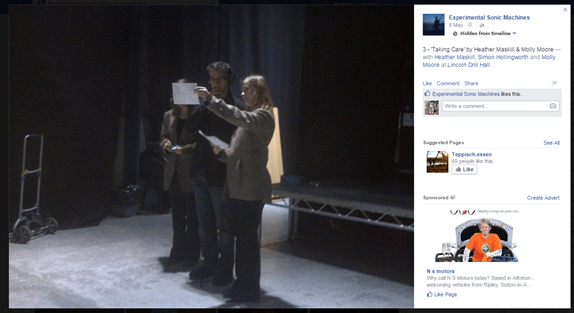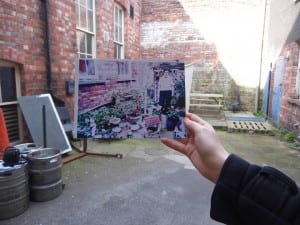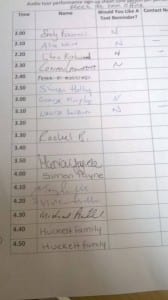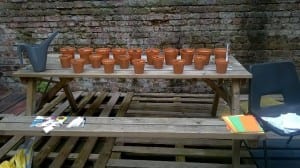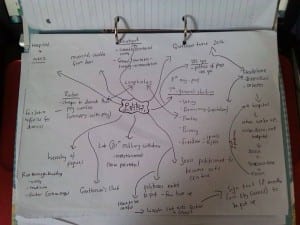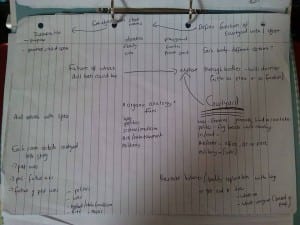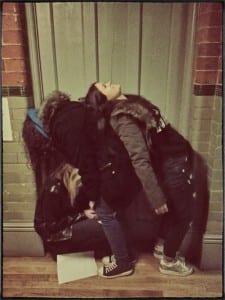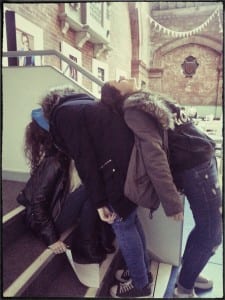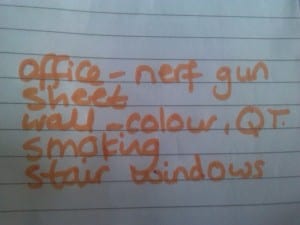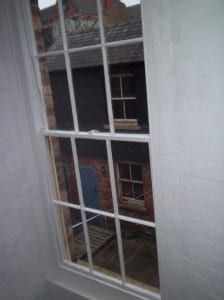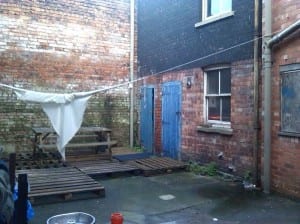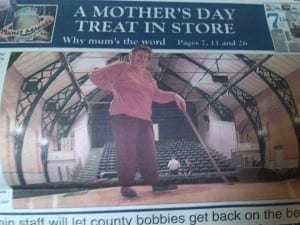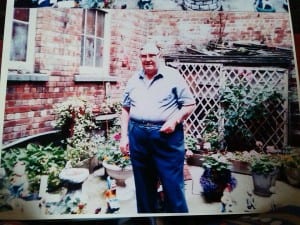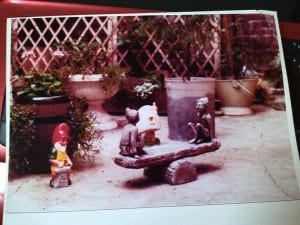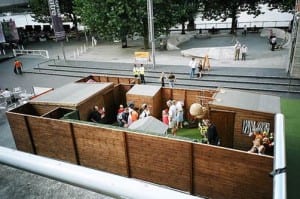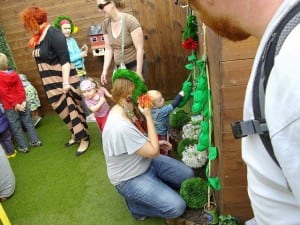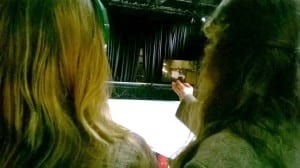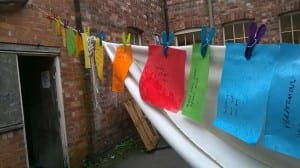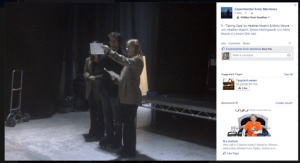‘It’s not just about the place, but the people who normally inhabit and use that place’ (Palmer in Pearson 2010, 8)
Framing statement
Taking Care was a site specific performance performed at the Lincoln Drill Hall on Friday the 8th of May 2015. The piece involved the audience being guided round the Drill Hall listening to the memories of the Huckett family whilst looking at corresponding pictures. At the end, they were asked to plant a flower to being the garden back to its former beauty and write down a memory of the Drill Hall. They were then offered a sherbet lemon- a favourite sweet of the Huckett’s. The tour lasted seven minutes and was performed every ten minutes from 2pm to 5pm. As the tour was for one audience member at a time we created a sign-up sheet so as to avoid confusion or disputes.
The tour started by the Plaque that Betty unveiled which commemorated the Drill Hall opening as an arts venue in 2004. The audience were then guided to the auditorium (where they looked at a picture of boxing day celebrations and the room before the café wall was built), the cellar where the children and grandchildren looked for ghosts and finished in the courtyard which was the Huckett’s old home and garden and where the audience were asked to plant a flower and for a memory.
The concept for Taking Care was formed through researching other site specific performances that took place in similar venues, with similar sources and performance space. Through adapting this research and combining it with our ideas, the idea of a guided audio tour was created.
Our main research influences were:
Spring by Metro Boulot Dodo
Making time by Raisin and Willow
Her Long Black Hair– Janet Cardiff
These were assisted by:
Where a Place becomes a site: Values by John Newling
Research and sources from interviews with family members
The script of the tour was based on quotes and anecdotes from family members and a newspaper article that covered the 2004 opening.
The aim of our piece was to commemorate Betty and Albert’s lives and to help their legacy stay alive. We aimed to do this by telling memories of them and their home and by involving the audience in an important part of their lives.
Analysis of process
When visiting the Drill Hall for the first time, the place that caught my eye was the courtyard that was only visible from the stairs leading to ‘The Room Upstairs’. I liked the way it was a small, seemingly separate space that was kept hidden and off limits to the public.
The second time I visited was with the Site group and we were given a guided tour. On entering the courtyard we were told two facts that stood out that made the space, what Winnicott calls ‘potential space’ (Pearson 2010, 11) with many narratives.
- The big wall that joined onto the car park was shorter on the other side due to the amount of concrete. This was only discovered when the vans from Question Time visited and the vans looked abnormally tall
- The two storey house with no doors used to be the Live in Caretakers’ home and the courtyard used to be their garden. It was mentioned that there were pictures of the garden.
After researching drill halls and how they were maintained, I found that it was common for them to be looked after by retired sergeants who provided training in return for accommodation. This meant it was possible that the other rooms were for committee meetings and secretarial and administrate offices.
These small snippets of research indicated three main areas of research and potential narratives:
Politics
Betty Huckett
Military
Because of my interest in politics and the performance date being the day after the general election, I decided to focus my ideas and research on politics and came up with some diagrams of my thoughts and thought process.
My ideas seemed to focus on politics being part of Durkheim’s organic analogy and so I decided to list other parts of it, such as education, crime and work, and how these could give the space a new purpose as part of possible future uses of the Drill Hall.
Now that I knew what the courtyard used to be and what it must have meant to a family, I started to appreciate the space more and became interested as to why it changed from a home to a smoking and storage area. I already had a vague idea of what the rooms had been used for and so began to wonder what they could become in the future, either as a part of or separate to the Drill Hall.
As one of our exercises, we used Willi Dorner’s ‘Bodies in Urban Spaces’ to get us to look for unnoticed spaces in the Drill Hall. One unnoticed space was a small alcove in one of the corridors between the café and auditorium. Three people went into the alcove, formed a shape and then recreated it on the stairs, where their bodies had to be adapted enough to fit the space but slight enough to keep a similar shape.
The adaptability of bodies and the idea of a space being a place or a function- for us, the space stopped being a place within the Drill Hall and became functional as it was filled with our re-enacted body shapes. The concept of a space being a function rather than a place made me wonder what the space looked like as a home and garden and how and why it had gotten to its current state.
Another of our exercises was Pearson’s ‘Some exercises towards relating space’. The first exercise I did was to write ten words to describe the place:
The second was to take only two photos that I felt represented the space. I took these two as they showed how the space was kept hidden away and represented how it was used to store items that were rarely used or needed.
These photo, I feel, focus on the material remains that Lorimer focuses on for his research on overlooked landscape features (Lorimer in Pearson, 2010, 14-15) Which would then form the basis for what Wilkie sees as the site becoming the story-teller (Pearson, 2010, 8)
By now most people had a favourite space or topic they wanted to look into. Molly and I both liked the courtyard and were interested in Betty Huckett and so teamed up.
Although the space had lots of future potential, we wanted to focus on what it had previously been so as to allow the space to ‘perform as much as it makes actors perform’ (Wiles in Pearson, 2010, 7), and not ‘dominant signifier’ (McAuley in Pearson, 2010, 10) awaiting a performance. This is because ‘Site-specific can be especially powerful…as a potent mnemonic trigger, helping to evoke past times’ (Harvie in Pearson, 2010, 9) Inspired by creating an authentic original by Forsyth and Pollard’s ‘Filed Under Sacred Music’ and the state of neglect, our first idea was to create an ‘authentic original’ garden installation based on the photos mentioned in the tour. Through stimulating the senses, we wanted to audience to be able to experience the privacy and intimacy of a garden that would hopefully become a permanent feature of the drill hall, acting as a permanent monument to the Hucketts.
The drill hall didn’t have any photos of Betty or her garden so we looked at obituaries on-line and found the first names of her children and grandchildren. To find them, I made the most of social media and was able to find two of her grandchildren on Facebook and arranged to meet up with them to find out about her. Whilst talking I found out that both Betty and Albert looked after the Drill Hall and lived there with their four children, and were later on visited by their grandchildren. They also told us some anecdotes that meant a lot to them or that stuck firmly in their minds:
Albert painted a big blue flower on the back wall to cheer the place up
One of the grandchildren used to look in the cellar and be scared by the sound of traffic
The Hucketts loved sherbet lemons and chopped Brazil nuts and had plenty to offer to guests
This small detail we felt captured the essence of Betty and Albert and the focus of our piece so we ended each performance by offering the
audience a sherbet lemon. ‘
They then gave me some copies of photos of Betty and Albert, the Drill Hall as it was and the garden. These were accompanied by two pages of memories from one of Betty’s daughters and a newspaper article commemorating Betty re-opening the Drill Hall in 2004. We knew that if we were able to incorporate these memories into our piece, what Pavis called an ‘unsuspected power’ (Pearson, 2010, 7) would be added to the piece through a new, more personal, first hand relationship with the audience.
Now that we had these crucial photos, we wanted to put them to greater use as they would help, as, according to Heddon, it would help the space to unfold it’s autobiography and would add more resonance to the piece, making the space, the material and the human co-creatives. (Pearson, 2010, 11)
Our second idea was inspired by Raisin and Willow’s 2009/10 durational piece, Making Time. The brief of this piece was to ‘explore ideas of time and endurance; performance and presence, within the framework of one year’ (Raisin and Willow, 2010) and so they decided to create a garden in Lancaster University’s concrete clad campus- a ‘shady, neglected’ Raisin and Willow, 2010) space outside the theatre and gallery of Lancaster’s University. The project was a year-long and it was all recorded on a web cam and an occasional brown paper newsletter. The audience could also visit the space on open days. Raisin and willow were only in the space for 60 out of 365 days and left exactly a year after they started, but ‘it was our labours, our simple presence that constituted the performance’ Raisin and Willow, 2010) The space still exists but, rather than a performance, exists as a ‘new ‘space’ in the fabric of the university campus’ (Raisin and Willow, 2010) The piece has its own archive that is on display in the Manton room at Lancaster University and features ‘treasures’ from the project including the seed packets and tools used in the process.
This piece interested us as our chosen site had many similarities to Raisin and Willow’s site: A concrete space outside an arts venue that was untouched. As site, like Kaye said, is characterised by focus on the ‘process rather than object’ (Pearson, 2010, 7), we wanted to develop our initial installation idea by showing the audience the time and effort that went into creating a garden or a home, which would hopefully make them appreciate their spaces more, as well as celebrating the space as a garden and not as a cigarette butt covered storage space. By redefining the space as a garden it would create a nicer space for the staff and visitors of the Drill Hall whilst creating a long lasting tribute remembering Betty and the impact she had on the Drill Hall and others’ lives.
In order for the documentation and the intentions of the piece to have the most impact, we thought of projecting a time lapse of the process of creating the garden and it growing onto a screen, possibly the white sheet that hung in the courtyard. When the film and performance finished, the garden, like in making time, would become a new space in its own right, rather than a tribute performance.
Described as ‘An ‘outlandish, innocent and interactive garden’ that charters innocence and acceptance ‘ (Metro Boulot Dodo, 2005), Spring was created with the intention of binging theatre to those who may not otherwise get to experience it. Spring is a portable performance space inside four eight foot walls that is based in Leicester town centre. As part of Metro Boulot Dodo’s project, Four Seasons, Spring fully immersed the audience in the life of Polly- an eight year old girl- through a combination of live performance, original soundtrack and new media. The project carries on today and the audio, pictures and video are available on their website for people to experience for free.
Metro Boulot Dodo, Spring, (2005)
Inspired by the concept of interacting with different periods of peoples’ lives through the combination of audio and visual media, we thought of turning the instillation into an interactive piece where the process was the performance. As part of a pre-performance, we thought of recreating Betty’s garden to use as a starting point. We then would get visitors to record their memories of a garden or outdoor space and play the memories through speakers whilst we arranged the materials in the garden, adapting the space to create the spaces of their memories. By the end of the day, the space would be an amalgamation of everyone’s garden, giving the space a new meaning and creating a link between the audience members and the Hucketts.
Our fourth idea and our final piece’s inspiration came from Janet Cardiff’s Her Long Black Hair, an audio tour round New York of the memories of the woman in the photos. The photos captured an unnamed woman standing in places in New York. Occasionally the audio would instruct the audience to hold up a numbered photo that corresponded with the view.
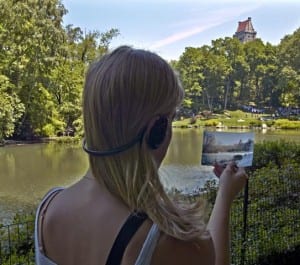 Cardiff, Her Long Black Hair (2004)
Cardiff, Her Long Black Hair (2004)
The juxtaposition on the old photos couple with the modern, busy New York made the audience feel as though they were in two times: ‘One foot in the past and one foot in the future’ (Derkson, 2012, 4) Although it has finished, the audio and pictures are still available on her website so it can be experienced either at home or in New York.
After being given copies of original family photos, we wanted to incorporate these primary sources and use them to their full potential. This piece gave us the inspiration of how to do it through the memories, anecdotes and newspaper article and the physical photos, the history of the Drill Hall had made the performance, all we needed to do was to use them in such a way that would involve the audience. By combining the memories into one part- an audio tour- and adding them to the use of the photos, we had the start of a performance. We had originally focused on the courtyard- as that was our favourite area, but now we had photos and memories of other rooms, we decided on the courtyard being the final space we they visited. By walking through the Drill Hall to the spaces, the audience would also be taking part in what Philips saw as a choreographed, visible activity, a performance in itself. (Philips, 2005, 509)
We also wanted to make use of the newspaper article about Betty opening the Drill Hall. The front page of the paper, we felt, introduced Betty well and set the context for our piece so we decided to make use of it during the sign-up as part of a pre-performance so the audience would be informed enough to understand the piece.
We now had the basis of our final idea but we wanted to develop it more and make it more interactive. Our solution came from one of our previous ideas and Newling’s piece Where a Place becomes a site: Values. In this piece, shoppers were asked to exchange a value in return for a piece of cloth with a question mark on it. The values were noted and were later used to form part of a script for another performance. Through this post performance, the involvement of the audience had formed another piece.
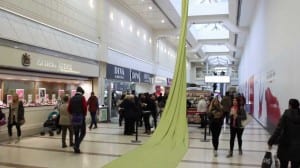 Newling, Where a Place becomes a site: Values (2013)
Newling, Where a Place becomes a site: Values (2013)
Our third idea- of recording the audience’s memories and adapting the space accordingly fitted well with this research and our intention. To apply the performance to the space more, we decided that, rather than record a memory of a garden, the audience would write down a memory of the drill hall which would then be hung off the rope to form a mini installation.
As the piece was based on Betty and Albert and their time as caretakers in the Drill Hall, we decided to integrate the notion of taking care into the piece by looking after the audience and naming the piece Taking Care, as we would literally be taking Care of the audience by guiding them round and helping them.
Rather than telling them where to walk to and when to hold up the pictures like in Cardiff’s piece, we decided we would do that for them, letting them enjoy the performance, just like Betty and Albert: ‘They were extremely proud of their work and made sure that the various people renting the hall always found it clean, warm, welcoming.’ (Huckett, M. 2015). So we had a chance to interact with the audience less formally than we had at the beginning (where we had to get the introductory information across), we decided to have the ending requests recorded on the audio and have us provide them the necessary equipment.
Performance evaluation
At first I thought that site specific was about putting on a performance in the place where it was set. After reading doing this module, I realised that space can be the performance, rather than it awaiting a performance to bring it to life. A performance can be anywhere or anything as everywhere has a history with individual stories and relations. Through research and development, these histories can be brought to life as a performance, either by recreating it or representing it. It doesn’t have to be a play to be a performance.
We had sixteen people take part in our piece out of a possible eighteen. The audience seemed to enjoy listening to the memories whilst seeing the differences between the photos and the present and some laughed during the tour complimented us at the end. The CEO of The Drill Hall who knew Betty told us that he didn’t know she had gnomes in her garden. I believe these aspects worked well as the audience got to feel part of someone’s memories without intruding. As physical touch was involved there was the potential for awkwardness or uneasiness among the audience. However, as we introduced ourselves and asked if physical contact was ok (and it was included in the sign up description), we created a rapport of trust with the audience that, Like Burden’s Five Day Locker Piece, redefined our role as a caring one (Zerihan et al, 2009). If we were to do it again, we would have had shelter for the rain set up, rather than holding an umbrella and having to transfer the audio device, as on one occasion, this resulted in the headphones being pulled out. We would also two tracks, one for the tour and one for the instructions, so there were no gaps or overlaps during the planting.
Our aim was to commemorate Betty and Albert’s lives and to help their legacy stay alive and I believe we did this. As well as some guests taking photos of the tour and sharing them on-line, the Drill Hall wanted to keep the seeds planted, which, as Myers says, ‘becomes a lasting part of the story’ (Pearson, 2010, 16) adding to, and continuing their legacy in the Drill Hall and people’s actions and memories.
Word count; 3,275
Bibliography
Personal
Huckett, M. (2015) Memories of the Drill Hall [letter] Sent to Heather Maskill, 22 February. [Accessed 27 February 2015].
Websites
Cardiff and Miller (2004) Her Long Black Hair. [Online] Avaliable from http://www.cardiffmiller.com/artworks/walks/longhair.html [Accessed 14 March 2015].
Metro Boulot Dodo (2005) Four Seasons| Spring. [Online] Avaliable from http://www.metro-boulot-dodo.com/spring.html [Accessed 12 March 2015].
Nottingham Contemporary (2013) Where a Place Becomes a Site: Values [Online] Available from http://www.nottinghamcontemporary.org/event/where-place-becomes-site-values [Accessed 5 April 2015].
Raisin and Willow (2010) Making Time. [Online] Avaliable from http://raisinandwillow.co.uk/projects/making-time/ [Accessed 5 March 2015].
Journals/books
Derkson, C. (2012) Walking the edge of the stage in theory: or, Janet Cardiff’s Sensorium for Intermedial Bodies. Theatre Research in Canada, 33 (Spring) 1-23
Pearson, M (2010) Site Specific Theatre. Hampshire: Palgrave Macmillan
Phillips, A. (2005) Walking and Looking. Cultural Geographies In Practice, 12 (October) 507 – 513.Zerihma, T et al. (2009) One to One Performance. ThisisLiveArt, 1-93.
Media
Experimental Sonic Machines (2015) [Facebook] 8 May. Avaliable from https://www.facebook.com/pages/Experimental-Sonic-Machines/545357728887794?fref=ts [Accessed] 8 May 2015.
Scott, A. (2004) Done and Dusted. Lincolnshire Echo. 20 March, 1-2.
Images
Her long black hair: http://www.cardiffmiller.com/artworks/walks/longhair.html
Spring: http://www.metro-boulot-dodo.com/spring.html
Where a Place becomes a site: Values http://i.ytimg.com/vi/SxJC12KqZsQ/maxresdefault.jpg
